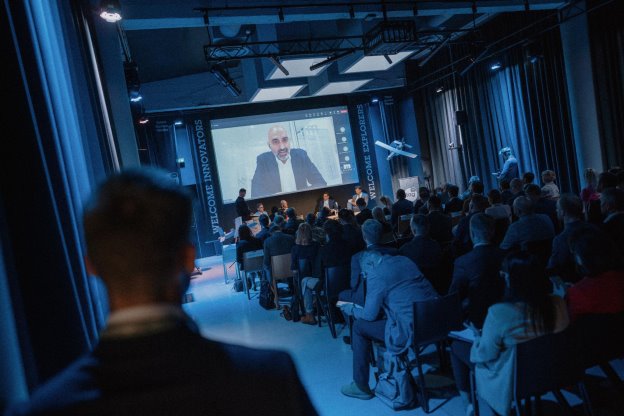Emerging tech in defense: Lithuanian showcase ahead of NATO Summit

Presenting a glimpse into the forefront of Lithuanian defense innovations deployed in Ukraine, an event organized on the eve of the NATO Summit in Vilnius provided a practical showcase of how emerging technologies are changing the nature of warfighting and set the groundwork for closer intra-NATO collaboration on emerging disruptive technologies.
NATO’s Focus on Emerging Disruptive Technologies
During the pre-NATO Summit event held in Vilnius on July 10th, 2023, titled “Innovation & Investments for Defence, Deterrence & Security,” Greta Tučkutė, Vice Minister of Defence of the Republic of Lithuania, highlighted lessons that need to be learned from Ukraine, where defense innovations are currently tested: “It is highly important to have high-quality and timely products in place for when we need them. Collaboration is important to understand what kind of product is expected from the government and what kind of product can be used by the armed forces. The NATO Summit is a crucial moment for our country and an opportunity to create models to boost defense investment and production while facilitating innovation collaboration among members.”
Andrea Traversone, the newly appointed Managing Director of €1B NATO Innovation Fund (NIF), emphasized the role that innovation plays within NATO: “Innovation in emerging and disruptive technologies must be responsible and led by fundamental principles: safety, freedom, and human empowerment. All of which are synonymous with NATO’s democratic values and the NIF’s mission.”
Mr. Traversone also encouraged smaller nations to become early adopters of emerging disruptive technologies, highlighting their potential role as leaders in driving the innovation agenda and promoting wider technological adoption within the alliance.
“The Vilnius Summit holds immense importance for defense innovation, particularly with the operationalization of NATO’s pioneering innovation incentivization mechanisms—the NATO Innovation Fund and NATO’s Defense Innovation Accelerator for the North Atlantic (DIANA). We were delighted to welcome the Managing Directors of both institutions to our event, fostering connections with the Lithuanian VC and technology ecosystem and paving the way for future collaborations,” Viktorija Trimbel, Managing Director of CoInvest Capital and co-host of the event added.
Lithuanian VC Funds: Fuelling Innovation
As Lithuania’s role in the geopolitical and innovation spheres gains prominence, the nation’s venture capital funds have stepped up to the plate. Lithuanian VC funds have amassed a significant $55M dry powder, earmarked explicitly for dual-use investments.
Andrius Milinavičius, Managing Partner of Baltic Sandbox Ventures, emphasized the importance of such funding: ” We focus on DeepTech (which encompasses Dual-Use tech) because we appreciate how complex the innovation commercialization journey is – starting with foundational R&D and finding applied use cases are two equally important tasks. Especially when working with startups aiming to navigate the dual-use sector, we need to help them by taking an activist role in hand-holding and helping these innovations reach end-users.”
From the Lithuanian Labs to the Ukrainian Frontlines
The event showcased an array of innovative solutions developed by Lithuanian SMEs, with capabilities spanning electronic warfare, long-range initiators, anti-drone solutions, space lasers, and non-jammable UAVs.
These aren’t just theoretical developments but practical, field-tested technologies that have proven their mettle in the Ukrainian conflict. As Dominykas Milašius, Venture Partner at Baltic Sandbox Ventures, affirmed, “These emerging tech solutions not only contribute to Ukrainian forces in their ongoing counter-offensive but also provide a new model for warfare that can benefit all NATO members. Some of them are already proving the value of their tech on the frontlines.”
“War in Ukraine is starkly demonstrating the imperative for innovation adoption, which can only happen when the private sector, governments, and academia collaborate, and access to capital is ensured across the wider spectrum of technology development.” — Giedrimas Jeglinskas, Non-resident Senior Fellow at the Atlantic Council, former Assistant General Secretary at NATO
In her opening statement at the event, Erika Kuročkina, Vice Minister of Economy & Innovation of the Republic of Lithuania, stated, “A vast expanse of opportunities lies ahead in diverse sectors such as aerospace, AI, and photonics. Our defense industry is open and collaborative, focusing on cutting-edge technologies. We aim to drive economic growth through these technological advancements, even as we strengthen security and provide assistance to Ukraine.”
With a robust infrastructure that Lithuania has built in less than two years, it is ready to channel this capital into promising startups, cultivate more disruptive technologies, and further the nation’s defense capabilities.
Lessons for the future
Deeph Chana, the CEO of NATO’s DIANA, described a future roadmap for technological talent attraction: “I see talent as highly contested in the future. The type of technologists we want to attract are not what we have currently proliferated – but we want to see them inside the national defense systems.”
Describing innovative models for delivering innovation to the frontlines, Jonas Öhman, Founder of Blue/Yellow For Ukraine said “During a hybrid war, we need a hybrid approach and solutions. The concept of Support Hybrid Warfare means that the NGO arranges cooperation involving government entities, businesses, civil society, and military units. The goal is to provide support accurately and quickly to military units, often upon requests direct from the battlefield. It also allows for deployment of new and untested systems to the frontline, for immediate feedback and necessary improvements.”





